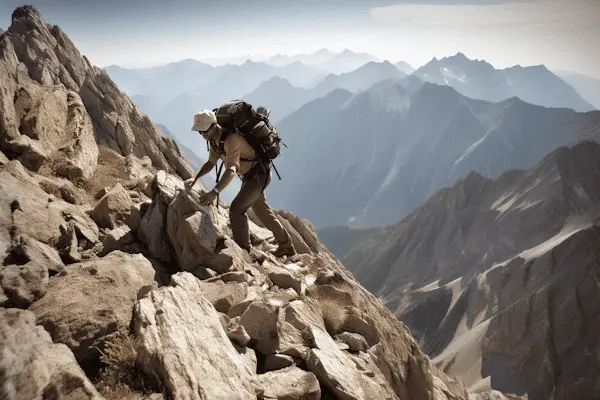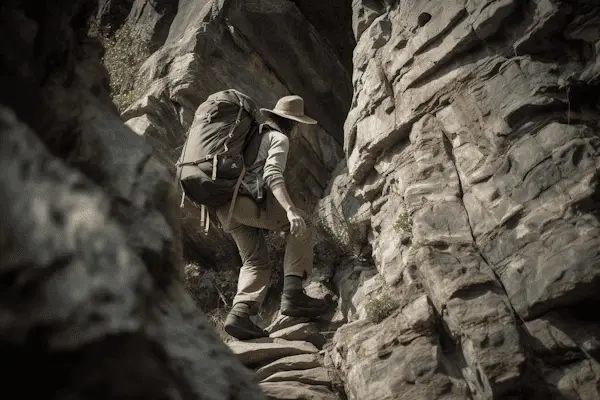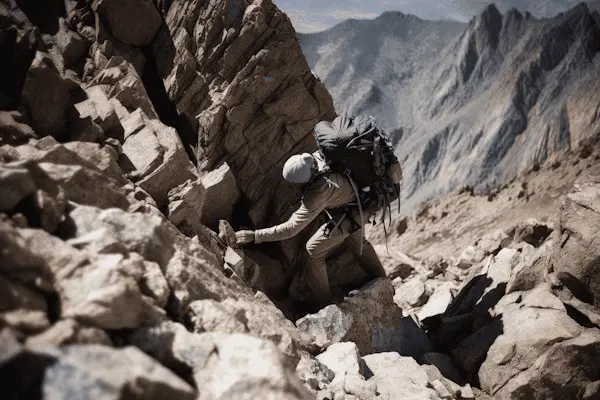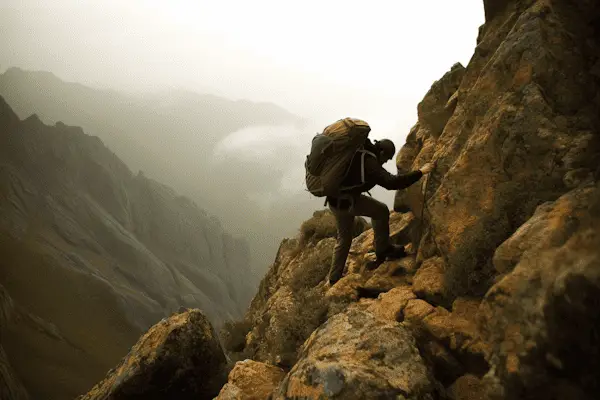I was new to hiking and a friend of mine recommended a nearby trail. He said he liked the trail because there were some spots where you had to do some scrambling. I didn’t know what that meant but I found out soon after hitting the trail.
So what is scrambling in hiking?
Scrambling in hiking is a type of hiking that involves climbing up steep or rocky terrain using your hands and feet. It’s a step up from regular hiking, but not quite as intense as rock climbing. Scrambling can be a fun and challenging way to explore the outdoors and push your limits.

The Scrambling Spectrum: From Simple Walk-ups to Complex Ascends
Scrambling really is a spectrum, you know. It’s a bit like the Goldilocks story – it sits just right in the middle of a hike and a technical rock climb. But let’s break it down a bit more.
On one end of the spectrum, you have the ‘walk-ups’. Sounds simple, right? Well, it usually is. This is where scrambling starts to dip its toes into the world of off-trail hiking. You’re essentially walking uphill, but the terrain is a bit trickier than your average trail. Maybe you need to use your hands for balance or navigate over some larger rocks. But don’t worry, it’s nothing too intense.

Then, in the middle of the spectrum, we’ve got scrambles that require a bit more handwork. You’re using your hands to pull yourself up, maybe even doing a bit of easy climbing. You’re not just walking anymore – it’s definitely more challenging, but you’re not in ‘rock climbing’ territory yet.
Now, on the far end of the spectrum, that’s where things get really interesting. This is where scrambling starts to overlap with technical rock climbing. You might find yourself on steeper terrain, having to navigate tricky sections, or even use some basic climbing moves. It’s still considered scrambling because you’re typically not using ropes or other climbing equipment, but it requires a higher level of skill and experience.
Each end of the spectrum offers its own unique thrill, and as you progress in your scrambling journey, you might find yourself drawn to the challenge of more difficult scrambles. Just remember to always prioritize safety and know your limits – not every scramble is for every scrambler, and that’s perfectly okay.
Scrambling Difficulty Ratings
Scrambling is often categorized using the Yosemite Decimal System (YDS), which is a popular classification system for rating the difficulty of hikes, scrambles, and climbs. The system starts at Class 1 and goes up to Class 5.
- Class 1: This is basically hiking on a good, well-defined trail. The terrain is easy, and there is little to no risk of falling.
- Class 2: This level involves off-trail hiking or “cross-country” travel that may require a bit of route finding. It can involve small amounts of scrambling with the occasional use of hands for balance and support. There might be some exposure (i.e., steep drop-offs nearby), but the risk of falling remains relatively low.
- Class 3: Now we’re getting into true scrambling territory. Class 3 routes require plenty of hand use for balance and support. Climbing skills become more important, and exposure is likely more noticeable. A rope might be used for safety, but it’s generally possible to move up and down without one.
- Class 4: This is where scrambling starts to blend into climbing. Class 4 routes require more complex climbing moves and have greater exposure. A fall could be fatal, so many people will use a rope for safety on these routes, even though they may not be technically necessary.
- Class 5: This is full-on rock climbing. It requires technical climbing skills, and a rope and other climbing gear are usually necessary for safety. Class 5 is further subdivided into decimal points (like 5.1, 5.2, etc.) to indicate the level of difficulty.
Remember, these classifications are subjective and can vary depending on individual skill level, comfort with exposure, and local conditions. Always research and prepare for your route thoroughly to ensure a safe and enjoyable scrambling experience.
Distinctive Gear: Essential Equipment for Safe Scrambling
You wouldn’t go into a football game without your helmet and cleats, would you? In much the same way, you need the right gear when you hit the scrambling trail. But don’t fret, it’s not as intimidating as it might sound.
First up are your trusty hiking boots. A pair of sturdy, well-fitting hiking boots is absolutely essential. You want something with good ankle support and a solid grip, because you’ll be tackling terrain that’s more unpredictable than a typical hike.
Now, let’s talk about your hands. Some scramblers like to wear gloves for better grip and protection against sharp rocks. That’s optional, but worth considering, especially for more challenging scrambles.
And then there’s the helmet. Yes, a helmet! While it might not be necessary for easier scrambles, as you move towards the rock-climbing end of the spectrum, a helmet becomes increasingly important for protection against falling rocks.
Don’t forget about a good backpack, too. It needs to be comfortable and roomy enough for essentials like water, food, a first-aid kit, and maybe a map or a guidebook. Just remember, the lighter the pack, the easier the scramble.
Lastly, if you’re venturing into more complex scrambles, you might consider carrying a lightweight climbing harness and a short rope. These aren’t usually necessary for most scrambles, but can provide added security in tricky spots.
The Skillset of a Scrambler: Necessary Skills for Scrambling
Scrambling is not just about physical strength, it’s also about having the right set of skills. And let me tell you, these skills can make the difference between a memorable adventure and a potentially dangerous outing. So, what’s in the toolbox of a skilled scrambler?
Firstly, a good sense of balance is key. You’ll often find yourself navigating uneven terrains, or on narrow ridges, where a good sense of balance will keep you steady and sure-footed.
Next up is route-finding. Unlike most hiking trails, scrambling routes aren’t always clearly marked. You need to be able to read the landscape and make smart decisions about the safest and most efficient way to move forward. If you’re new to this, it might be a good idea to scramble with more experienced companions or hire a guide.
Another important skill is understanding and assessing risk. Not every scramble is for everyone. You need to be aware of your capabilities and comfort level. It’s essential to know when to push forward and when to back off. No shame in turning around if it feels too sketchy.
And last, but not least, is basic first-aid knowledge. Accidents happen, even with the best preparation. Knowing how to react in case of an injury can literally be a lifesaver.
A Step Further from Hiking: Transitioning from Walking to Scrambling
Ever wonder how you can take your love for hiking up a notch? Well, scrambling might be your answer. It offers that extra kick of adrenaline that your usual hike might be missing. But hold on, before you start leaping over rocks and scree, let’s talk about how you can make the transition from a hiker to a scrambler.
First, start slow. You don’t have to dive into the toughest scrambles right away. Begin with easier scrambles that feel a lot like your usual hikes, just a tad more exciting. As you gain more experience and confidence, gradually move on to more challenging routes.
Next, learn from others. Join a local hiking club that organizes scrambles. Being around more experienced scramblers can be hugely beneficial. You’ll pick up tips, tricks, and valuable insights that you might not find in any guidebook.

Another important step is to boost your fitness. Scrambling is more physically demanding than hiking. It often requires upper body strength and greater stamina. Incorporate exercises that strengthen your arms, legs, and core into your workout routine.
Lastly, remember that knowledge is power. Educate yourself about the different aspects of scrambling. Read books, watch instructional videos, maybe even take a scrambling course. Being well-informed will make your transition smoother and safer.
Scrambling can add an exciting new dimension to your outdoor adventures. So if you’re ready for a bit more thrill on your trail, it might be time to take that step further from hiking.
Risk and Reward: Evaluating Safety in Scrambling
Every adventure comes with a bit of risk, right? And scrambling is no exception. But before you get cold feet, let’s chat about how we can evaluate and manage those risks to ensure our scrambling adventures are more reward than worry.
First up, always check the weather. Sounds simple, but it’s a step often overlooked. Sudden changes in weather can turn a safe scramble into a risky one. So, keep an eye on those forecasts and be prepared to change your plans if Mother Nature doesn’t cooperate.
Next, always be aware of your surroundings. Falling rocks are a common hazard in scrambling. Keep a safe distance from climbers above you and always wear a helmet when you’re on the steeper terrains.
Also, never underestimate the importance of preparation. Make sure you’re physically fit for the challenge and familiar with the route. And remember, there’s no shame in turning back if something doesn’t feel right. Pushing beyond your limits can quickly turn an adventure into a disaster.
Last, but not least, make sure someone knows your plans. Whether it’s a park ranger or a friend back home, let someone know your route and when you expect to return. This simple step can be a lifesaver in case of an emergency.
Scrambling is an incredible way to experience the great outdoors. With a bit of risk management, you can ensure that your adventures are thrilling, rewarding, and most importantly, safe. After all, the mountains will always be there for another day.
10 Tips For Scrambling: Use These To Get Started
Here are ten more scrambling tips to help you get started.
- Preparation is Key: Always research your route beforehand. Understand its complexity and hazards. Check weather forecasts and make sure to pack all the necessary equipment and food for your journey.
- Start Gradually: If you’re new to scrambling, start with easier routes that have less exposure and technical challenges. As your confidence and skill level grow, you can gradually take on more challenging scrambles.
- Fitness Matters: Scrambling can be physically demanding. It requires a good level of fitness, particularly strength in your arms, legs, and core. Regularly doing exercises to improve your strength, balance, and endurance can greatly enhance your scrambling experience.
- Safety First: Always wear a helmet, especially in areas where there is a risk of falling rocks. In more challenging scrambles, you might also consider carrying a lightweight climbing harness and a short rope for added security.
- Leave No Trace: Respect nature by sticking to established paths, carrying out all trash, and avoiding disturbance to wildlife.
- Learn Basic First Aid: Knowing what to do in an emergency situation can be a lifesaver. A basic knowledge of first aid is crucial for anyone venturing into the outdoors.
- Take Your Time: Scrambling is not a race. It’s important to move at a pace that’s comfortable for you, taking time to rest when needed. Remember, it’s all about enjoying the journey!
- Trust Your Gut: If something doesn’t feel right, it’s okay to turn back. It’s better to err on the side of caution than to take unnecessary risks.
- Communicate Your Plans: Let someone know your route and when you expect to return. This way, if something unexpected happens, someone knows where you are.
- Keep Learning: Even experienced scramblers can learn something new. Whether it’s improving your route-finding skills, learning new scrambling techniques, or understanding more about mountain safety, continuous learning should be a part of your scrambling journey.
Epic Scrambles Worldwide: Top Destinations for Scrambling Adventures
Who doesn’t love a good adventure story, especially when it involves some of the most spectacular scrambles around the world? So, whether you’re an experienced scrambler or a newbie looking for your next challenge, here’s a round-up of some epic scrambles that might just pique your interest.
Starting off in North America, the Canadian Rockies offer some of the best scrambles. Mount Rundle in Banff National Park, for instance, is a classic scramble with amazing panoramic views at the summit. And if you’re heading south, Angel’s Landing in Zion National Park, USA, offers a thrilling scramble with sheer drops and stunning red rock formations.
Over in Europe, the UK is a hotspot for scrambling. Tryfan in Snowdonia, Wales, is a beloved classic. And the Cuillin Ridge on the Isle of Skye, Scotland, is an exhilarating and technically challenging scramble.

If you’re down under, Australia’s Mount Beerwah in Queensland offers a great scramble up a volcanic plug with stunning views of the Glass House Mountains.
And for those looking for high-altitude scrambles, Mount Toubkal in Morocco and the Matterhorn in Switzerland provide challenging scrambles along with breathtaking alpine scenery.
Remember, while these scrambles are incredible, they each come with their own unique challenges and risks. Always research, prepare, and ensure you’re up to the challenge before setting off. And who knows, maybe one day you’ll have your own epic scramble story to tell.
Preserving the Trail: The Ethics of Scrambling
Alright, scramblers, let’s talk about the environment. You see, scrambling isn’t just about conquering peaks and seeking thrills. It’s also about respecting nature and leaving as little impact as possible. So, what can we do to ensure our scrambling adventures are both fun and sustainable?
First things first, stick to established paths whenever possible. Even though scrambling often involves off-trail navigation, try to minimize your impact by following worn routes and avoiding trampling on delicate vegetation. The phrase “Leave no trace” should always be in the back of your mind.
Next, let’s talk about trash. Carry out everything you carry in. That means all food wrappers, water bottles, and yes, even toilet paper. It’s a small act that goes a long way in preserving the beauty of our natural spaces.
Also, respect wildlife. Remember, you’re a visitor in their home. Keep a safe distance, and never feed or disturb the animals you encounter.
And lastly, respect other scramblers and hikers. Keep noise to a minimum, yield to climbers coming uphill, and always lend a hand if you see someone in need.
In the end, scrambling is about more than just personal achievement. It’s about being a responsible outdoor enthusiast who respects nature and helps preserve it for future generations.
